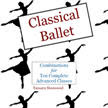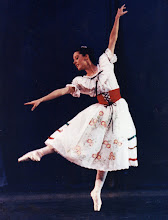Friday, November 6, 2009
New Web Site!
Thanks!
Thursday, November 5, 2009
Dancers and Conditioning
I’ve often wondered how common it is for a dancer to suffer from chronic back pain during and after their dancing career. I personally had a lot of issues with low back pain while I was dancing, and I attributed much of it to the repetition of particular moves in choreography and to the fact that I have a long torso (which in my mind was not conducive to dancing ballet). Now that I’m suffering the long term effects of chronic back pain and getting older, I’m realizing that there were things I should have been doing to supplement my core strength in order to counterbalance the excessive flexion that dancing demands. It never occurred to me that dancing ballet six or more hours a day was not enough.
I knew that if I did crunches and stretched out before class that I would perform extensions and hold balances better, but I didn’t focus enough on really strengthening my abdominals, my back, and stretching out my hamstrings the way I should have. Not only that, I have since learned that aerobic or cardio training could have helped my dancing as well. An article from the Harkness Center for Dance Injuries web site states, “Aerobic fitness can increase blood flow and oxygenation to all tissues, including the muscles, bones, and ligaments of the spine. Dancers should be encouraged to cross-train year round to maintain aerobic fitness.”
Sean Fyfe is a physiotherapist working with Metis Physio Centres in London, a multi-disciplinary clinic and he works with elite dancers and theatre performers. From an article at sportsinjurybulletin.com, he says, “Dancing alone doesn’t ensure abdominal strength, good activation through glut max or activation of segmental stabilisers. In that respect, dance is no different from any other sport: its performers have to put aside the time to do specific body maintenance, in conjunction with regular screening, to give themselves the best chance of remaining injury free.”
I have begun taking yoga classes and wish I’d known the value of yoga and Pilates back when I was dancing. The mindfulness (or meditation) that comes out of practicing yoga is giving me tools that allow me to be a calmer, happier person—more capable of administering to the needs of my my family or coworkers and simply being able to breathe and be in the moment. At yogamindfulness.com, they explain that meditation doesn’t have to be something you hole up alone in a quiet room to do; it can be done just by being mindful and living in the present. Visualizing breath as it enters and leaves the body, noticing the state of your body at any moment in time, using your senses fully to take in the world around you—any of these can be a form of meditation.
Dancers are focused so much on their bodies, and I personally think it would do a world of good for them to also nurture their minds and spirits in a holistic way. We used to make fun of the modern dancers and called them “granola” people for the way they utilized breath and didn’t attempt to hide the effort in their movements. Now I see that they were really onto something that ballet dancers would do well to heed, too. Not that ballet dancers will ever want to enunciate their breathing on stage, but I think it would be great if teachers taught their students to breathe in and out with the counts during class, much like they do in yoga. With age cometh wisdom, and hindsight is always 20/20, right?
Here is a great book for dancers with information about anatomy and kinesiology.
Tuesday, November 3, 2009
Monday, November 2, 2009
Thursday, October 29, 2009
Stage Parents
Wednesday, October 28, 2009
Monday, October 26, 2009
Teaching Creative Movement

Ballet class with children ages 3-5 is often called “creative movement” rather than ballet class. Then at age 6 it is sometimes referred to as “pre-ballet”, which is when they are usually ready to stand at the barre and learn the mechanics of alignment and ballet positions. Creative movement can be taught many different ways—none better or more effective than another—so I will just share some of the things I did with this age group (and felt were effective) when I was teaching them dance.
First of all, kids this age don’t have a very long attention span! Two minutes is about as long as you can stretch one activity before moving on to something else. I always felt that a 45 minute class was the absolute longest these kids could handle, unless you are combining it with some tap, too. I’d also say that if you have more than eight children in the class then you should probably have an assistant there to help you out.
I structured my creative movement classes more or less the same way each week. Kids do like repetition and it helps them feel more comfortable if they have a good idea what to expect. We would begin sitting on the floor in a circle, wide enough that when they put their arms out to the sides they wouldn’t touch their neighbor. At the beginning you can have them sit cross legged or with the soles of their feet together or their legs stretched out straight in front of them. Sitting cross legged is easiest for them, and when you want them to focus attention on sitting up straight and using good posture through their backs, necks long, and shoulders down, this is helpful.
Still in the circle we would also sing a lot. There are several songs that some children may already know or can pick up quickly that you can easily add movements to. I liked “Open, Shut Them”. You sing Open, Shut Them, Open, Shut Them, Give a little clap clap clap, Open, Shut Them, Open Shut Them, Put them in your lap lap lap. You can do variations on this using your hands like in prayer position or using your legs to open to a straddle and close legs together straight in front of you. Then you can sing Creep Them, Creep Them, Creep Them, Creep Them Right down to your toes (crawling with fingers down outstretched legs in front and toward their toes) and repeat Creep Them, Creep Them, Creep Them, Creep Them, Right back to your nose.
In the circle you can also work on flexing and pointing the toes and flying like a butterfly using pretty arms with the soles of the feet together. They also enjoyed lying on their bellies with their heads towards the center of the circle, practicing pushing up onto their hands and keeping their necks long (like a cobra in yoga), and lifting their heads and their feet off the ground and flying like Superman.
Practicing little rhythmic patterns is a fun thing to do in the circle as well. You can have them help you make up four count or eight count phrases such as clap hands 2X, clap hands to knees 2X, clap hands to shoulders 2X, and put both hands on your head, hold count 8. You can repeat with only one clap in each position, etc. Adding head movements and even facial expressions is a great way to interact with them and get them working on putting together patterns.
In the center there are many activities you can do with this age group. Props are fun, too, especially if you have colorful scarves they can improvise with at the end of class. I tried to incorporate learning how to hop on one foot, gallop, skip, walk toe to heel across the floor like on a tightrope, and eventually even learning a small polka step on demi pointe and plié (step R, L on demi pointe, step R in plié, repeat LRL across the floor). You can reverse that polka, too, and do down, up, up…down, up, up. It’s amazing what children this age can pick up. When you feel like you’re losing them, go back to imitating an animal to get their attention again. Take light springy steps like a cat, heavy steps like a gorilla, etc.
At the end of class we’d always put a scarf or something down in the center that they could run and jump over one at a time. The idea would be to leap leading with their right leg the first time, and then starting at the other upstage diagonal leap leading with their left leg, but usually you are lucky if they manage to just leap and land on one leg instead of two. It’s a really fun age to teach. I think when I was teaching this level I was too worried about getting enough “technique” into each class. But really, having them move to music and count out rhythms and learn patterns is truly enough. At this stage it’s most important that they enjoy what they are doing.
Maybe other teachers of creative movement have more to add. And I think that never having danced at this age myself, it’s harder for me to say exactly what’s so important about it and what’s not. I don’t think it can make or break a dancer, unless you become too exacting and they tire of it before it’s really time to begin working on technique. Please share your thoughts!









